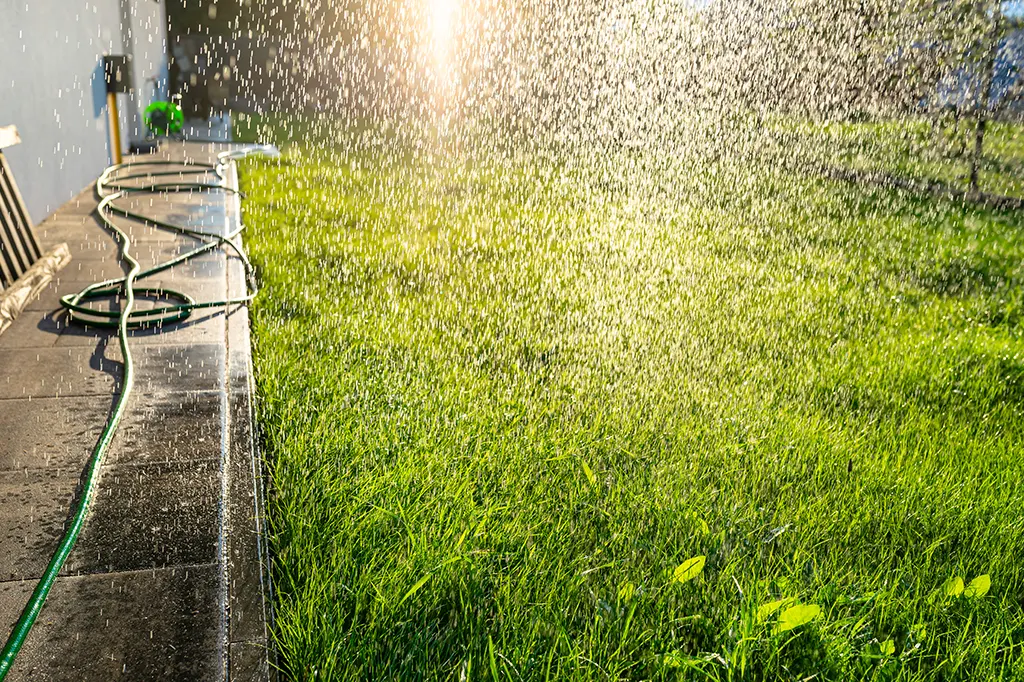
Installing fresh sod is an exciting step toward achieving a lush, green lawn. However, proper care in the first month is crucial for ensuring strong root development and long-term health. If you’re wondering how to care for new sod, this guide will walk you through everything you need to know, from watering schedules to mowing tips. Let’s take a closer look at each step in detail.
Watering Your New Sod
Immediately After Installation
Water your new sod within 30 minutes of installation. You should thoroughly soak the soil underneath to help the grass blades settle and encourage root growth. A good soak ensures that the sod remains moist and starts bonding with the soil beneath it.
First 2-3 Weeks
For the first few weeks, water daily. Your new sod needs at least an inch of water per day, or more if the weather is hot or dry. Keeping the soil consistently moist is required for root establishment. If your area is experiencing high temperatures, consider watering twice a day to prevent the sod from drying out.
During this period, check moisture levels by lifting a corner of the sod. The soil underneath should be damp but not overly saturated. If it feels dry, increase watering frequency; if it’s muddy, scale back slightly.
After 2-3 Weeks
Once your sod begins to take root, gradually reduce watering frequency. Start watering every other day, then transition to every few days depending on the weather conditions. The goal is to encourage deeper root growth so your lawn becomes more drought-resistant.
This change is needed because watering too often after the first rooting phase can lead to shallow roots. This makes the grass rely on regular irrigation. Instead, longer and less frequent watering sessions encourage the roots to grow deeper into the soil, leading to a healthier, more resilient lawn.
Best Time to Water
Water in the early morning. This allows the grass blades to dry before night time, reducing the risk of fungal diseases. Morning watering also ensures that the sod gets enough moisture before the heat of the day sets in, preventing excessive evaporation.
Avoid Overwatering
Too much water can be just as harmful as too little. If you notice puddles forming, you may be overwatering. Overwatering can suffocate roots and lead to disease. Signs of overwatering include a spongy feel when walking on the grass or the presence of mould or fungus.
To check if your lawn needs water, use a screwdriver or soil probe. If it easily penetrates the soil up to six inches deep, your lawn has sufficient moisture. If it’s difficult to push in, it’s time to water.

Minimizing Foot Traffic
New sod is delicate. Try to stay off your freshly installed sod for at least two weeks to prevent compaction and root damage. Foot traffic can disrupt the rooting process and weaken the sod’s ability to establish itself properly. Even after a month, try to keep the foot traffic light to give the rooting system time to become stronger.
Mowing Your New Lawn
When to Mow
Wait at least two weeks before mowing. Ideally, the grass should reach about 3.5 to 4 inches before its first trim. Cutting it too soon can disturb the roots before they have properly anchored into the soil.
How to Mow
Use a mower with blades that are sharp to avoid tearing the grass. Dull blades can damage grass blades and cause stress, making your new sod more vulnerable to disease. Set your mower height to avoid cutting too much at once—removing more than one-third of the blade length can stress the new sod. Instead of mowing directly over the freshly laid sod, mow around the perimeter first to minimize stress on the grass.
For best results, mow when the grass is dry, as wet grass tends to clump and cause uneven cuts.
Fertilizing New Sod
Wait at Least 30 Days
Hold off on fertilizing for the first month. This allows the sod to establish itself without overstimulating growth. Fertilizing too soon can promote top growth instead of root development, leading to a weaker lawn in the long run.
Follow Application Instructions
Apply fertilizer according to the package instructions. Over-fertilizing can burn the grass and do more harm than good. Be sure to spread it evenly and avoid applying it right before rain to prevent runoff.
Monitoring Your New Sod
Check your lawn regularly for signs of over- or under-watering, disease, or stress. If you notice any sections that seem dry, adjust your watering schedule accordingly. Healthy sod should be firm, green, and well-rooted after the first month.
Ensure a Healthy Lawn
Taking the time to properly care for your new sod in the first 30 days ensures a healthy, long-lasting lawn. With consistent watering, minimal foot traffic, careful mowing, and proper fertilization, your sod will thrive and establish strong roots.
Investing effort early on will save you from future lawn issues and maintenance headaches. With the right lawn care routine, your new sod will reward you with a beautiful, lush yard for years to come.
Need help with your lawn care? Contact Lavington Turf Farms for expert advice and premium-quality sod.